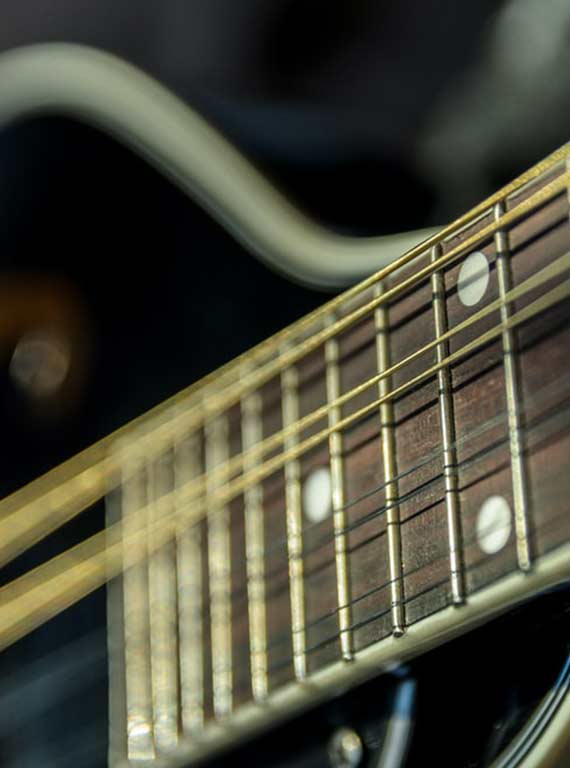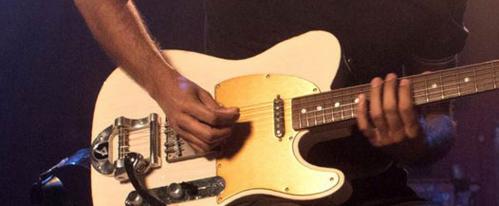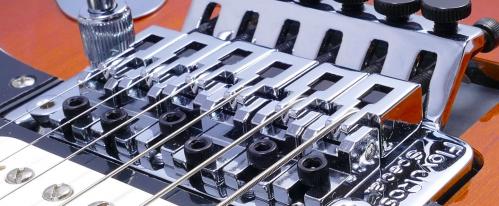We offer up a quick and easy guide to Electric Guitar String Gauges so you can choose the right set for your playing style and your guitar
Choosing electric guitar strings can be a little bit daunting if you don’t know what you’re looking for or if you’ve not been through the “trial and error” phase that we all must go through as guitarists. But not to worry, as today we’re going to explain the different types of electric guitar string gauges and guitar string sizes so you have a better idea of what you need to look for when it comes to choosing a set of strings for your electric guitar.
Feel free to watch our very helpful video guide featuring Sam from Portsmouth below, and read on for our beginner’s guide to electric guitar string gauges as we not only aim to explain the differences between guitar string gauges, but also explore the various metals that they can be made from and how these factors will affect your guitar’s tone and playability - as well as which types of strings are best for certain players.
Choosing the right electric guitar string gauges
In today’s blog, we’re going to be using Rotosound strings as they’re one of our favourite string brands here at PMT.
Rotosound is a British company with over 50 years of string-winding behind them, and all of their strings are made here in their factory in Kent. They sound and play great, having been put through a rigorous quality-control process, and they’ve got a huge list of famous endorsees stretching all the way back to The Who, Hendrix and The Beatles. So, if it’s good enough for them, it’s definitely good enough for me and you!
But there’s one unique reason why we recommend Rotosound strings to customers, and that’s because most of their electric guitar sets come with a free extra top E string. If you’re anything like the guitarists here at PMT, that’s the one that’s always breaking first - so it’s nice to have a spare in your gig bag.

So let’s talk string gauges…
When we refer to the gauge of a string we’re talking about it's thickness. Strings are measured in thousandths of an inch - so for example, a gauge 9 high E measures .009 inches thick, whereas a standard 42 gauge low E measures .042 of an inch. So, you can see why it’s easier for us to refer to them as 9’s, 10’s, 11’s etc.
These tiny differences in thickness are really hard to see with the naked eye. A ruler or tape measure won’t help you either, and a guitar luthier will usually have to use a micrometer to accurately determine the gauge of a string. But it is amazing how these tiny fractions between different string thicknesses affect the way they feel and sound.
As a general rule, thinner gauge strings are easier to play and bend, but they do tend to break more easily, don’t have quite as much volume and sustain, and they can be a bit more prone to fret buzz, especially on a guitar with low action.
Thicker gauges generally produce a better tone with more sustain, they tend to snap less frequently, but they are harder to play, requiring more pressure from your fingers to fret and to bend.
There is no standard guitar string gauge, or a set of standard guitar strings - it really is up to you which ones you prefer to use based on feel and tone.


In summary
- Thinner strings are easier to bend but tend to break quicker
- Thicker strings are harder to play but tend to last longer and are ideal for down tuning
Most packs of strings though come in standard “pre-gauged” sets, and these are pretty universal across all string manufacturers. The two most popular sets are super-lights - that’s gauge 9 to 42s - and lights or regular - which are 10s to 46’s.
If you bought your guitar brand-new, it probably came setup with a set of 9 to 42’s. So that’s a gauge 9 high E string, an 11 for the B string, gauge 16 G string and then gauges 24, 32 and 42 for the D, A and low E strings.
You’ll also notice that the three treble strings are unwound or plain whereas the bass strings are wound to make them thicker and produce a bigger, more resonant tone. You can see what we mean in the picture below.
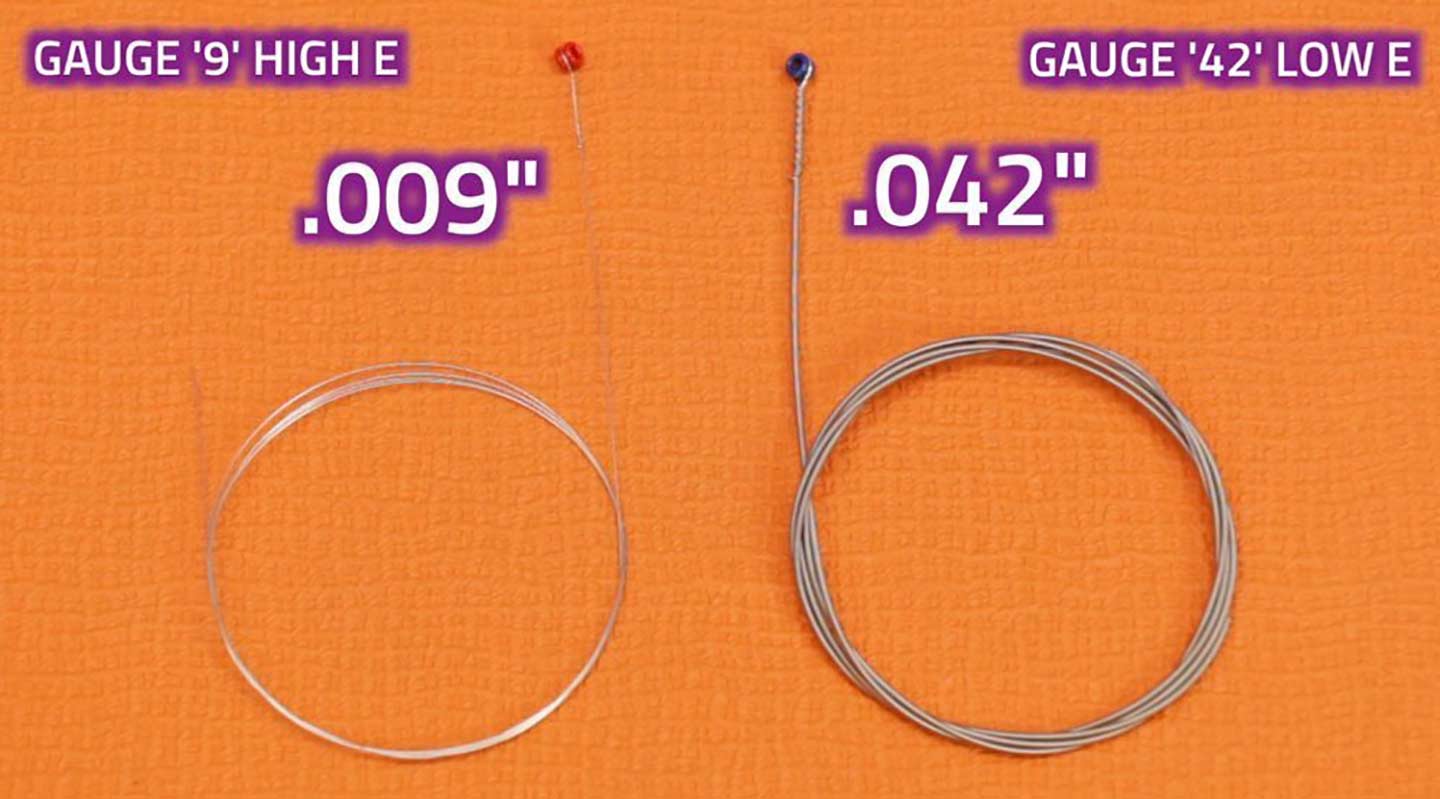
On acoustic guitars, you’ll find that the G string is usually also wound - but this is less common on electric guitars. Some players do prefer to replace a standard G with a wound G as they feel it balances the tone and aids the intonation of the guitar - it does make them pretty difficult to bend though, so it's not always ideal if you’re a lead player.
Usually, guitarists will jump up a gauge of strings from the super-light 9 to 42s, to the regular 10 to 46 gauge (10s as they're commonly known). Slightly thicker, or heavier as we like to say, this set features gauges 10, 13 and 17 for the high E, B and G strings, and a wound 26, 36 and 46 for the three lower strings.
As you can see in the images above, they're not too far away from the gauge 9 set, and a lot of players like to jump up to this gauge to add a little more tension and tone to the strings without sacrificing playability. But if you’re just starting out, you don’t need to worry about that just yet, as it comes down to trial and error. We recommend trying out a variety of different setups to see what works for you.
Here's a breakdown of the different string gauges from Rotosound:
How to choose guitar strings based on string gauges
Rotosound R8 Roto Greens Electric Strings, Extra Light 08-38
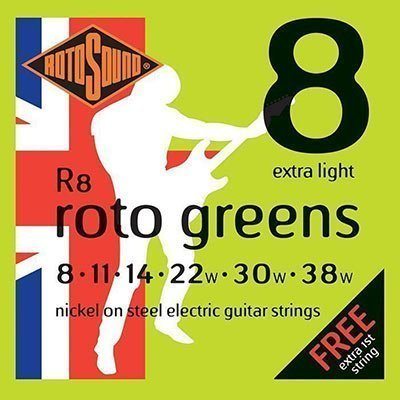
The Rotosound R8 Roto Greens Electric Strings, Extra Light 08-38 are some of the lightest guitar strings available and make a great beginner set as they won't hurt your fingers too much during the initial learning period. They are also a fantastic option for shredders, those who really wail on a Floyd Rose tremolo and those who want to fly around the fretboard without too much resistance.
Best for:
- Shredders
- Beginners
- Floyd Rose Tremolo users
Rotosound R9 Pinks Electric Guitar Strings 9-42

Commonly known as "9s" the Rotosound R9 Pinks Electric Guitar Strings 9-42 are super light strings that are easy to bend and perfect for the likes of those with a floating tremolo or players who don't want to have to press too hard when they play. These are a great option for beginners as they are easier on the fingers.
Best for:
- Beginners
- Those who prefer a lighter feel
Rotosound RH9 Roto Orange Hybrid Electric Guitar Strings 09-46

The Rotosound RH9 Roto Orange Hybrid Electric Guitar Strings 09-46 utilises the same treble strings as regular 9s, but use slightly fatter bass strings (which are found on the regular pack of 10s). This ensures you have the ability to bend easily, but maintain that thickness and resonance thanks to heavier bass strings. They are the best of both worlds.
Best for:
- Beginners
- Indie/rock guitarists
- Those who like to bend notes
Rotosound R10 Roto Yellows Electric Guitar Strings 10-46

The Rotosound R10 Roto Yellows Electric Guitar Strings 10-46 are ideal for all types of players, offering great resonance and tone as well as long-lasting playability. 10s are a great all-rounder and are used by beginners and professionals.
Best for:
- All players
- Rock/blues/everything
Rotosound RH10 Roto Blues Electric Guitar Strings 10-52

The Rotosound RH10 Roto Blues Electric Guitar Strings 10-52 feature light treble strings, but slightly heavier bass strings, making them ideal for those who like to bust out serious power chords or tune down to drop D.
Best for:
- Those who down tune to Drop D
- Those who like to play power chords
Rotosound R11 Roto Reds Electric Guitar Strings 11-48

The Rotosound R11 Roto Reds Electric Guitar Strings 11-48 are where things start to get heavy. If you bend one of these you really start to feel it. However, 11 gauge strings are often used by jazz players as they offer superb resonance and are rarely used to bend notes. They are also great for those who down tune their guitars to a lower key.
Best for:
- Those who play in lower keys
- Those who play 1/2 step down
- Those who like to really feel bends
- Those who don't bend strings at all
Rotosound R12 Purples Electric Guitar Strings Medium Heavy 12-52

If you start to use Rotosound R12 Purples Electric Guitar Strings Medium Heavy 12-52, you really need to start looking at having your guitar set up correctly to handle them - especially if you want to use regular tuning. 12s are used by guitarists who down tune and play in lower keys as they offer great resonance, tuning stability and playability for lower keys.
Best For:
- Metal/rock players
- Those who down tune a whole-step
- Those with guitars designed to play in lower keys
Rotosound R13 Roto Greys Electric Guitar Strings Heavy 13-54

The Rotosound R13 Roto Greys Electric Guitar Strings Heavy 13-54 have been designed for those who drop tune to the likes of Drop C and lower, offering superb playability at lower levels. If you want to drop tune, these are your best bet!
Be warned, if you throw a set of these on a guitar that has not been set up correctly to accommodate lower gauge strings, you risk damaging your guitar! So always have it set up correctly before using these strings.
Best for:
- Those who play heavy metal
- Those who play in lower/drop keys a full step or more down
- Those with guitars designed to play in lower keys
Scale Length affects the playability of the strings
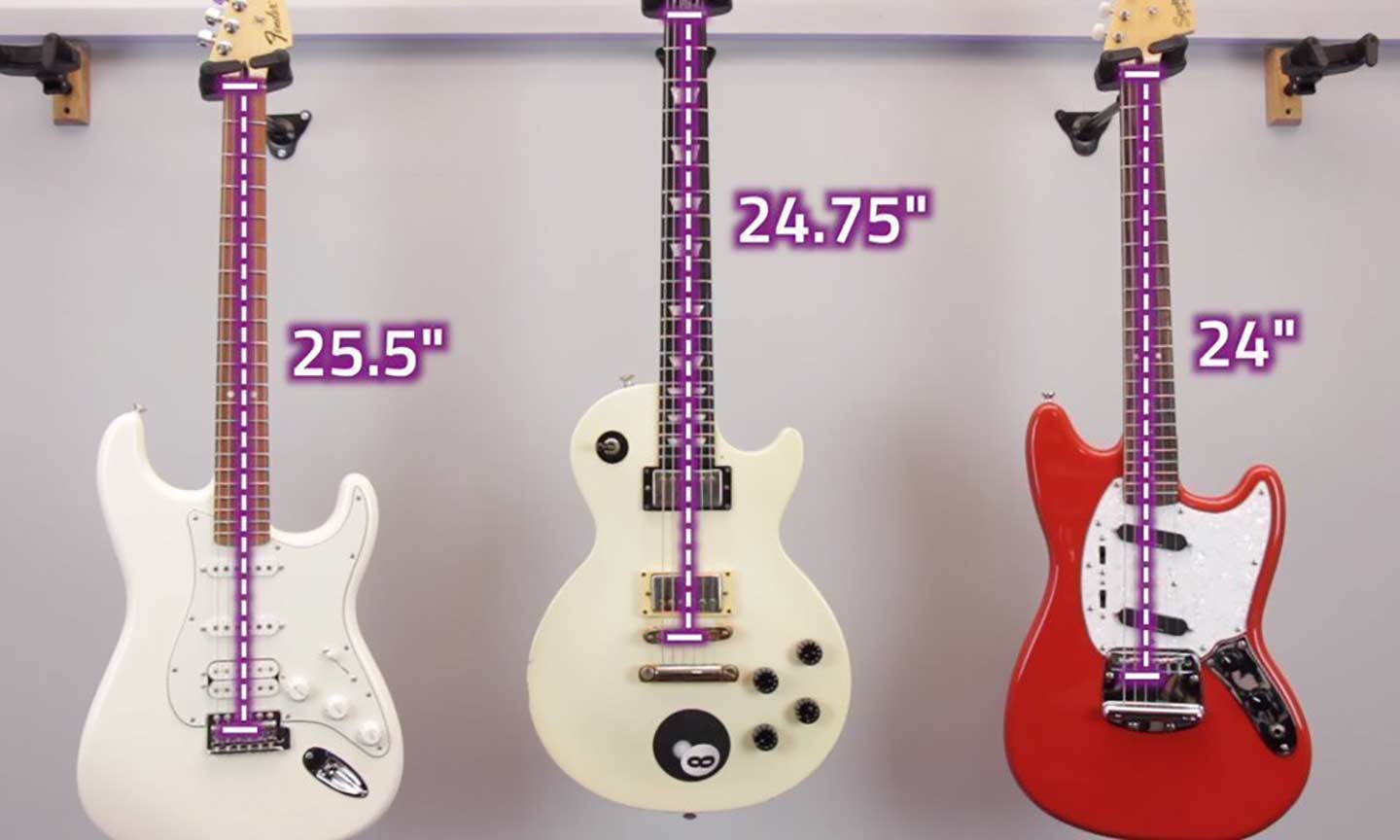
The shorter the scale length, the less tension a string will be under when tuned to pitch - which makes it feel easier or “slinkier” to play, allowing for more extreme bends.
This is ideal for shredders and blues guitarists, but it's also the reason that a lot of players prefer to go up one gauge of strings on a Les Paul. Due to it’s shorter scale, a set of 10’s on a Les Paul feels more akin to a set of 9’s on a Strat with that longer scale length.
Again, you don’t need to worry about that too much just yet as you may like the way 9s feel or prefer the way 10s feel. It’s up to you at the end of the day.
Some guitars will need setting up should you change gauge of strings
Now, on a fixed bridge guitar such as Les Paul, changing from 9’s to 10’s shouldn’t cause too many problems, sometimes just needing a very minor tweak to the setup to optimise tuning and stability of the guitar. This will most likely be a slight tightening of the guitar's truss rod to compensate for the extra tension on the neck - but you shouldn't worry too much about swapping between 9s and 10s as guitars are quite resilient. However, on a guitar with a tremolo, especially a locking, floating trem, any change to the gauge of strings fitted will need much more attention.
An electric guitar’s set-up is a delicate balance between the truss rod, which runs up the neck, the bridge and saddles and, on some guitars like Fender Stratocasters, the springs in the back of the tremolo.
When it comes to making drastic changes between electric guitar string gauges such as jumping from 9s to 11s or 10s to 13s, all of these aspects need to be adjusted to ensure that the strings stay in tune as you play up the neck, that’s what’s referred to as the intonation, they’re not too high off the fretboard, that’s called the action, and that the tremolo is sitting in the optimum position.

It can be a bit tricky, so if you’re unsure, definitely take your guitar down to one of our PMT stores for our experts to take look before changing your gauge of strings.
Warning!
Definitely don’t replace broken strings on a Jackson Floyd Rose Tremolo guitar with odd strings pinched from random packs you have lying around as the tension will be all over the place and the guitar will be almost impossible to tune.
Best strings for bending vs best strings for de-tuning
So, back to string gauges - there are other popular “standard” sets such as the extra super light 8-38 gauge which are popular with some of the super-fast shred style players who have a much more delicate, lighter touch.
Next, you’ve got the heavier gauges such as 11-56’s and 12-54’s, which are ideal for if you’re going to be down tuning your guitar. Iconic bluesman Stevie Ray Vaughn famously used 13-58’s on a Strat to get that monstrous tone of his. He would detune half a tone to Eb, which would lessen the tension a little, but still, but gotta have some pretty strong fingers to do what he did with those strings!
Detuning is pretty commonplace in heavier music styles, especially now with the popularity of 7 string and 8 string guitars, allowing for a deeper, sludgier, more brutal sound. A standard 6 string guitar is tuned E, A, D, G, B, E, but a lot of players such as Jimi Hendrix, Slash, Kurt Cobain, and as we mentioned earlier Stevie Ray Vaughn, liked to tune their guitars down a semitone to Eb as it offers a deeper, richer sound. More modern heavier players will tune down even further, usually by a whole tone, meaning the strings will be tuned to D, G, C, F, A, D, offering a much fatter sound, especially when combined with distortion.
Other popular de-tunings include Drop D - where just the low E string is downtuned by a tone, allowing you to play power chords with a single finger - as well as Drop C, where the entire guitar is downtuned a whole tone and then the lowest string is dropped yet another tone.
Just remember though, the lower you detune, the less tension will be on the string so that’s when you have to start upping the gauge to compensate. A lot of the players dropping to these more extreme tunings tend to have a pretty hefty low E string, somewhere around about the 60 gauge. But if you are planning on putting these heavy strings on your guitar, as well as the set-up adjustments we mentioned earlier, you may also need to do a bit of work to the nut to accommodate those thicker strings.

Again, if you’re unsure, get down to your local PMT store and let the team take a look for you.
What strings should I use?
To sum it all up - thinner gauge strings are easier on your fingers. but you do lose a little tone and might end up snapping more.. On the other hand, heavier gauges are tougher to play, especially if you’re just starting out, but offer a bigger tone and are great for downtuning.
So, your string gauge will usually depend on what you like to play.
Most players tend to use either 9’s or 10’s as they are easy to play and your guitar won’t really require a setup to play these sets. If you’re a beginner, or seasoned player either of these two gauges will usually be your go-to sizes.
Hybrid Strings
Hybrid string gauge sets offer up the best of both worlds.
Something like the Rotosound Roto Oranges feature the top 3 strings from a set of 9s and the bottom 3 from a set of 10’s. So, you get the “bendy” playability for your lead playing, but a thicker sound on the bass end for rhythm work. They are ideal for all types of players who use regular tunings.
Flatwound vs Roundwound
So, let’s move on to the different types of electric guitar strings. There are two main types of string, Roundwound or Flatwound. Flatwound have a very smooth feel to them, but offer a darker, duller tone with less response to picking dynamics, and these are most popular with Jazz guitarists – think the sound of Paul McCartney’s bass sound in the Beatles.
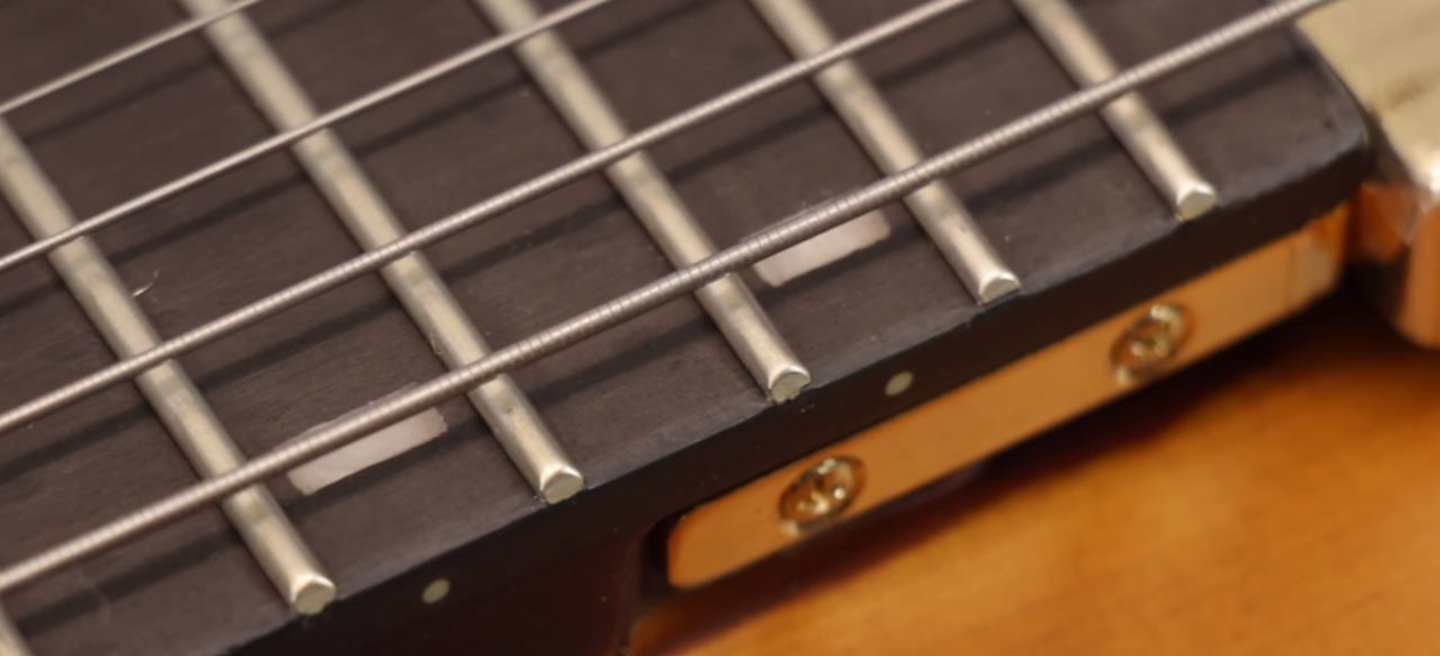
By far the most common type of string is round wound, which you’ll find on a majority of electric guitars, producing a lot more attack, sustain and overall bite and clarity when compared to flat wound. Chances are you’re most likely to use roundwound strings as flatwound are more a “specialist’s” type of guitar string.

How different materials affect tone
Most commonly, round wound strings comprise of a steel core with a nickel winding, but they can also be made from other alloys. Pure nickel strings are popular as they offer a slightly warmer, less bright tone to steels, and similarly, chrome strings sound warmer and offer less resonance, again very popular with jazz and blues players.
Stainless steel and titanium strings offer a brighter tone, and because they’re stronger, tend to last longer, but do bear in mind, playing strings made from these harder metals will eat away your frets a bit quicker, so always keep an eye out for fret wear. But don’t panic too much – it takes years and years of playing before any really noticeable difference to frets (on a high-quality guitar, anyway).
A selection of guitar string manufacturers also offer coated string options, where a polymer is added to the string to increase playing life. This helps resist corrosion and prolongs that nice smooth feel of a new set of strings.
When should I restring my electric guitar?
So finally, let’s quickly look at when it’s time to change your strings. If you don’t know how to correctly re-string a guitar, make sure to check out Dagan’s re-stringing guide on our channel, as he’s got loads of handy tips for you below:
There’s no hard and fast rule as to how often you should change strings, a lot of gigging guitarists will re-string every gig, whilst if you’re not playing much and not getting too sweaty you might get away with leaving it for up to a few months. But as a general rule, if your strings start to sound dull, feel a little rough and sticky, won’t hold their tuning, or you start to see signs of corrosion, it’s usually time to change.
It’s not much fun playing a guitar with old rusty strings and even worse, once they’ve started to oxidise and corrode, that’s when they start to cause damage to the frets of your guitar.
How to prolong string life
The main tips we can offer for prolonging string life would be these three steps:
- Always make sure your hands a clean before you play
- Wipe strings down afterwards with a clean rag to remove any sweat or dead skin
- Consider using a string cleaner and lubricant to keep them feeling fresher and smoother for longer
Simple!
So, that’s our guide to electric guitar strings and string gauges. We do hope it’s helped you figure out which strings you might need, especially if you’re new to the world of electric guitars. However, if you’re still confused, call in to any of your local PMT stores to speak to one of our guitar experts as we’re happy to help you find the correct electric guitar string gauges for your needs and playing style.
Shop a full range of electric guitar strings over at PMT online today. View the full selection of Rotosound electric guitar strings online too!

